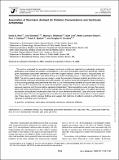| dc.contributor.author | Rich, David Q. | |
| dc.contributor.author | Schwartz, Joel | |
| dc.contributor.author | Mittleman, Murray A. | |
| dc.contributor.author | Link, Mark | |
| dc.contributor.author | Luttmann-Gibson, Heike | |
| dc.contributor.author | Catalano, Paul J. | |
| dc.contributor.author | Speizer, Frank E. | |
| dc.contributor.author | Dockery, Douglas | |
| dc.date.accessioned | 2019-01-14T14:58:38Z | |
| dc.date.issued | 2005-06-15 | |
| dc.identifier.citation | Rich, David Q., Joel Schwartz, Murray A. Mittleman, Mark Link, Heike Luttmann-Gibson, Paul J. Catalano, Frank E. Speizer, and Douglas W. Dockery. 2005. “Association of Short-Term Ambient Air Pollution Concentrations and Ventricular Arrhythmias.” American Journal of Epidemiology 161 (12): 1123–32. https://doi.org/10.1093/aje/kwi143. | en_US |
| dc.identifier.issn | 1476-6256 | en_US |
| dc.identifier.issn | 0002-9262 | en_US |
| dc.identifier.uri | http://nrs.harvard.edu/urn-3:HUL.InstRepos:37989560 | * |
| dc.description.abstract | The authors evaluated the association between ventricular arrhythmias detected by implantable cardioverter defibrillators and ambient air pollution concentrations in the hours immediately before the arrhythmia. Patients given implantable cardioverter defibrillators at the New England Medical Center in Boston, Massachusetts, between mid-1995 and 1999 who lived within 40 km of a central monitoring site (n = 203) were followed until July 2002. The authors used a case-crossover design to study the association between ambient air pollution and up to 798 confirmed ventricular arrhythmias among 84 subjects. The authors found that interquartile range increases in 24-hour moving average particulate matter less than 2.5 mu m in aerodynamic diameter and ozone were associated with 19% and 21% increased risks of ventricular arrhythmia, respectively. For each, there was evidence of a linear exposure response, and the associations appeared independent. These associations were stronger than associations with mean concentrations on the same calendar day and previous calendar days. The authors did not find associations with pollutant concentrations less than 24 hours before the arrhythmia. Cases with a prior ventricular arrhythmia within 72 hours had greater risk associated with air pollutants than did cases without a recent arrhythmia. These results confirm previous findings and suggest that matching of pollution periods to arrhythmias is important in detecting such associations. | en_US |
| dc.language.iso | en_US | en_US |
| dc.publisher | Oxford University Press (OUP) | en_US |
| dc.relation.isversionof | http://aje.oxfordjournals.org/content/161/12/1123.full.pdf | en_US |
| dash.license | META_ONLY | |
| dc.title | Association of Short-term Ambient Air Pollution Concentrations and Ventricular Arrhythmias | en_US |
| dc.type | Journal Article | en_US |
| dc.description.version | Version of Record | en_US |
| dc.relation.journal | American Journal of Epidemiology | en_US |
| dash.depositing.author | Dockery, Douglas | |
| dc.date.available | 2019-01-14T14:58:38Z | |
| dash.workflow.comments | 1Science Serial ID 2054 | en_US |
| dc.identifier.doi | 10.1093/aje/kwi143 | |
| dash.source.volume | 161;12 | |
| dash.source.page | 1123-1132 | |
| dash.contributor.affiliated | Dockery, Douglas | |


